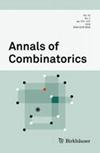残馀多集中年轻图的识别
IF 0.7
4区 数学
Q4 MATHEMATICS, APPLIED
引用次数: 0
摘要
对于任何杨图,我们都可以联想到它所有节点的残差多集。本文关注的是反问题:给定一个 \(\mathbb {Z}/e\mathbb {Z}\)的元素多集,它是否来自杨图?我们用费耶斯的核心块概念和多分区的权重概念,给出了杨多图的第一层次的完整解和更高层次的部分答案。我们应用第一层的结果来研究分区上的移位操作。本文章由计算机程序翻译,如有差异,请以英文原文为准。
Identifying Young Diagrams Among Residue Multisets
To any Young diagram we can associate the multiset of residues of all its nodes. This paper is concerned with the inverse problem: given a multiset of elements of \(\mathbb {Z}/e\mathbb {Z}\), does it comes from a Young diagram? We give a full solution in level one and a partial answer in higher levels for Young multidiagrams, using Fayers’s notions of core block and weight of a multipartition. We apply the result in level one to study a shift operation on partitions.
求助全文
通过发布文献求助,成功后即可免费获取论文全文。
去求助
来源期刊

Annals of Combinatorics
数学-应用数学
CiteScore
1.00
自引率
0.00%
发文量
56
审稿时长
>12 weeks
期刊介绍:
Annals of Combinatorics publishes outstanding contributions to combinatorics with a particular focus on algebraic and analytic combinatorics, as well as the areas of graph and matroid theory. Special regard will be given to new developments and topics of current interest to the community represented by our editorial board.
The scope of Annals of Combinatorics is covered by the following three tracks:
Algebraic Combinatorics:
Enumerative combinatorics, symmetric functions, Schubert calculus / Combinatorial Hopf algebras, cluster algebras, Lie algebras, root systems, Coxeter groups / Discrete geometry, tropical geometry / Discrete dynamical systems / Posets and lattices
Analytic and Algorithmic Combinatorics:
Asymptotic analysis of counting sequences / Bijective combinatorics / Univariate and multivariable singularity analysis / Combinatorics and differential equations / Resolution of hard combinatorial problems by making essential use of computers / Advanced methods for evaluating counting sequences or combinatorial constants / Complexity and decidability aspects of combinatorial sequences / Combinatorial aspects of the analysis of algorithms
Graphs and Matroids:
Structural graph theory, graph minors, graph sparsity, decompositions and colorings / Planar graphs and topological graph theory, geometric representations of graphs / Directed graphs, posets / Metric graph theory / Spectral and algebraic graph theory / Random graphs, extremal graph theory / Matroids, oriented matroids, matroid minors / Algorithmic approaches
 求助内容:
求助内容: 应助结果提醒方式:
应助结果提醒方式:


